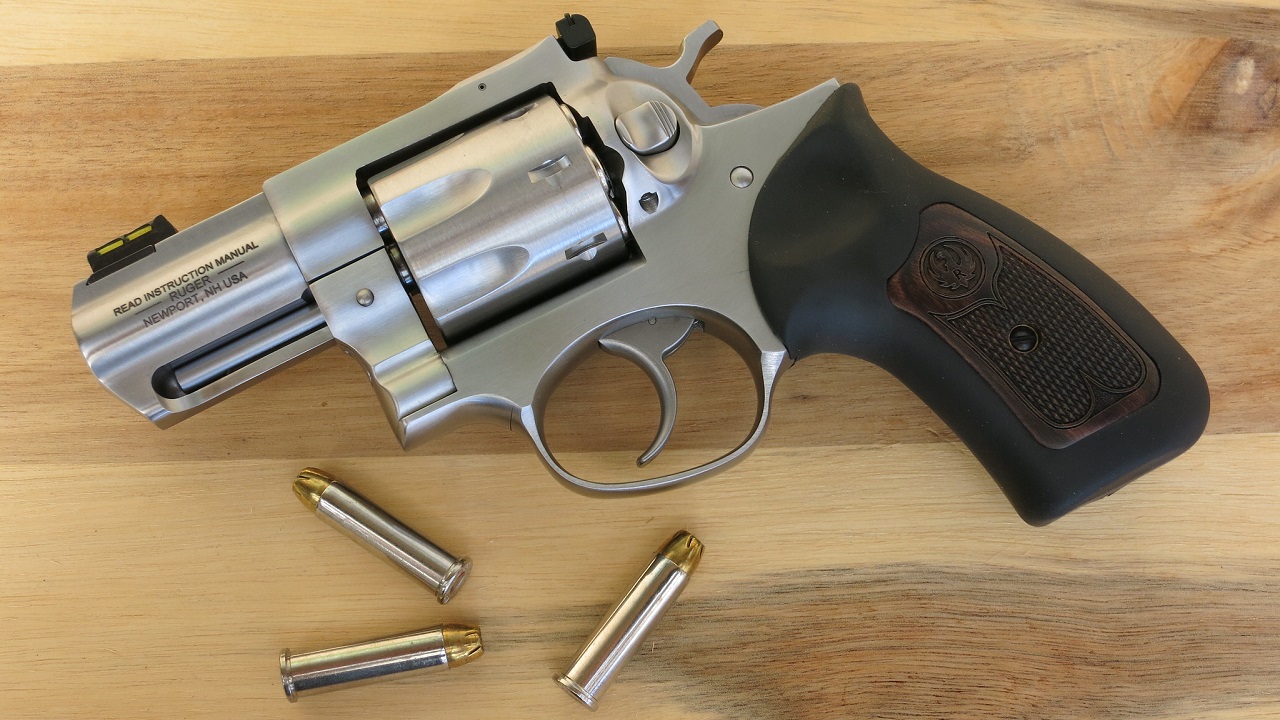The double-action (DA) revolvers of Sturm, Ruger & Co. Inc., especially their GP-100 in .357 Magnum, are a favorite.
So, when I found out that one of my local rental ranges had a Ruger GP-100 in .22 Long Rifle (LR) available, you’d better believe I jumped at the chance to try it out. I mean, my favorite revolver platform in a rimfire caliber that’s much easier on the pocketbook than any centerfire caliber? Gotta be the best of both worlds. Right?
Ruger GP-100 .22 LR History & Specifications
The original GP-100 in .357 Magnum debuted in 1985, and it quickly established a reputation for quality, in terms of accuracy, reliability, and incredible strength and durability. The firearm is able to easily withstand mega-hot loads that would destroy a competing brand wheelgun from Colt, Smith & Wesson (S&W), or Taurus. I fired first and became enamored with the GP-100 back in May 1990 and finally bought my own back in 2003.
The .22 LR chambering of the GP-100 came out in 2016. Specifications of this rimfire edition include a 5.50-inch barrel, an overall length of 11 inches, a weight of 42 ounces, stainless steel finish, and a 10-shot cylinder as opposed to the traditional “sixgun” capacity of wheelguns chambered for centerfire calibers.
Personal Shooting Impressions
As luck and convenience would have it, it was my nearest indoor shooting range, delightful ol’ Cindy’s Hot Shots in Glen Burnie, Maryland, that had a .22 LR GP-100 available for rental. The ammo selected was 50 rounds of Aguila High Velocity 40-grain Copper Plated Solid Point ammo, delivered from the Classic Weaver Stance and using the Thompson Target B27-IMZ Immobilize Zones paper silhouette target. (As a quick aside, remember my August 2022 article “Why Is Ammo Still Expensive?” Well, buying this box of .22 LR – a caliber that’s been so popular for so long thanks in no small part to its low price – cost me freakin’ $8.99! It wasn’t that long ago that 50 rounds of .22 LR would’ve easily cost under five bucks.)
The course of fire was as follows:
—7 yards, 25 head shots, all DA mode
—25 yards, 25 torso shots, all single-action (SA) mode
How did she perform? Did it live up to the high standards I’d come to expect as a lifelong fan of her centerfire counterpart?
To be brutally honest, though the .22 LR GP-100 performed adequately, the gun was a bit of a letdown. Admittedly perhaps I’d mentally set myself up for a letdown after setting the bar so high as the longtime owner of the .357 GP, but still, I gotta call it like I see it.
The ejector rod and the DA trigger were considerably stiffer on this specimen than either my personally owned .357 or the rental GP-100 Match Champion semi-custom gun I evaluated this past summer. The first cylinder of ammo that I fired was especially resistant to smooth and quick extraction and ejection, requiring an extra amount of force and elbow grease to expel the empty cases. Thankfully it got a wee bit easier than that, but not by much. In fairness, at least the SA trigger was still crisp, and there were no failures to fire in either DA or SA mode (.22 LR can be considerably finicky when it comes to ignition issues on account of light primer strikes.)
Accuracy of this .22 version also didn’t live up to the standards I’d come to expect from all my years of shooting .357 Mag and .38 Special through GP-100s. At 7 yards, my first two rounds went way high-left; yes, they still struck the skull of the target, but outside the indicated “Fatal-T and Spinal Immobilize Zone” scoring area of the target; after adjusting fire accordingly, I got my remaining 23 shots in the 10-point area (presumably representative of the cerebellum and medulla oblongata). At 25 yards, the high-left pull was even worse, way beyond the norm even for a cross-eye dominant right-handed shooter like myself, with four complete misses and five non-scoring peripheral hits on the silhouette. I had to take major “Kentucky windage” with a 5 o’clock hold in order to finally land six and eight hits respectively in the 10-point area (heart) and 5-point area (lungs) of the “Upper Chest Immobilize Zone” along with two spinal hits.
Bottom line: as much as I still love my centerfire GP-100, I won’t be rushing out to buy a rimfire edition anytime soon! Rather, when I finally do make my first .22 LR handgun purchase (yeah yeah, I know I know, what’s taking me so long, right?), I’ll most like get another Ruger product instead, namely their Mk IV autopistol (or maybe their 22/45, depending on how well I like it when I try it later this week).
Want Your Own?
Current MSRP is $1,059.00 USD. True Gun Value states that “A RUGER GP 100 .22 LR pistol is currently worth an average price of $1,021.76 new. The 12-month average price is $1,021.76 new.” I find this a tad surprising, as historically Ruger firearms have been significantly less expensive than their Colt and S&W competitors. But that doesn’t seem to be affecting the rimfire GP-100’s popularity, as multiple websites I researched for this article indicated that the sellers were sold out of them. In any case, Ruger Firearms Shop and Sportsman’s Outdoor Superstore both have an asking price of $729.00.
Christian D. Orr has 33 years of shooting experience, starting at the tender age of 14. His marksmanship accomplishments include: the Air Force Small Arms Ribbon w/one device (for M16A2 rifle and M9 pistol); Pistol Expert Ratings from U.S. Customs & Border Protection (CBP), Immigration & Customs Enforcement (ICE), and the Federal Law Enforcement Training Center (FLETC) Criminal Investigator Training Program (CITP); multiple medals and trophies via the Glock Sport Shooting Foundation (GSSF) and the Nevada Police & Fires Games (NPAF). Chris has been an NRA Certified Basic Pistol Instructor since 2011.
From the Vault

